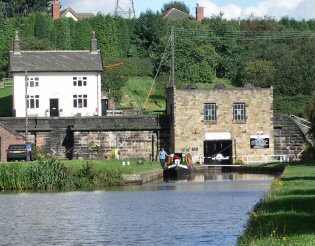Canal cottages to be refurbished
THE Canal & River Trust (CaRT) has announced it is to spend £1.5m to refurbish a number of its most historic canalside cottages.
The properties include lock keepers' cottages and toll houses that were constructed some 200 years ago, with many listed, with the work including peeling back the years of home decoration.
Best examples
The Trust is focusing on properties which are among the significant and best examples of their kind on the inland waterways. The programme has seen £750,000 invested in works on 13 cottages since 2011 and the Trust has announced a further £750,000 over the next three years as it plans to refurbish a further 12.
Peter Chowns, Conservation Architect at CaRT, comments:
"The Trust owns and cares for some of the finest examples of historic canalside cottages. Dating back to the 18th and 19th century, we want to conserve them because each helps tell the story of Britain's former industrial waterways and of the people who helped play a crucial role in the world's first Industrial Revolution.
"The work to restore these homes is revealing decades of well-intentioned but sometimes misguided decorating mistakes and 20th century maintenance oversights, ranging from use of impermeable modern paints and renders, to plastic gutters and upvc windows. I'm proud that the Trust is able to commit the money required to give them the care and attention they deserve and I'm eager to share the lessons learned with the many thousands of people who are the loving owners and current custodians of most of the nation's historic properties."
 Listed properties
Listed properties
The first properties amongst the 12 to be refurbished includes five Grade II* listed properties on the Buildings at Risk Register on the Llangollen Canal in Shropshire, the listed tunnel keeper's cottage at the end of Harecastle Tunnel on the Trent & Mersey Canal (pictured) and a semi-detached listed stone cottage on the Weaver which was actually taken down stone by stone and moved a couple of hundred yards in the late 19th century.
Canal & River Trust employs a team of specialist heritage advisors and a conservation architect to ensure that its historic buildings are well protected and sympathetically restored. Here are their top ten dos and don'ts for the Trust's properties, as well as the thousands of historic homes up and down the country owned by private individuals:
Dos and don'ts
Don't remove suspended timber floors and replace them with solid concrete. Old walls can become damp as they no longer benefit from the under floor air circulation that dried them as intended. This can cause deterioration of plaster and paintwork finishes.
Don't cover historic walls with modern impermeable cement-based renders, plasters or masonry paint. Old houses usually have solid walls and were built using breathable materials. Modern impermeable alternatives will trap moisture causing damp and condensation.
Don't re-point old walls with modern cement-based mortars. The pointing of old solid walls is generally made of lime mortar which is softer and wicks away moisture. Making repairs with modern cement mortars will impede this, ultimately causing damage to brick or stonework.
Don't replace historic features unless you have to, and then use matching materials. Modern plastic gutters and windows can perform just as well, but they don't have the historic integrity or appearance of the originals. Modern breathable paints reduce the need for regular repainting of timber, and traditional materials are more flexible and less prone to failure. Original features such as cornices, internal doors and fireplaces will also add value.
Do consider removing the polystyrene tiles and hard textured surfacing such as Artex applied to internal walls and ceilings in the 70s. It may have been the fashion then, but these finishes are not doing your historic property any good whatsoever, and may be masking further problems.
Do allow the odd draught. Excessive draught-proofing by blocking chimneys, and replacing old windows and doors with UPVC alternatives leads to condensation and damp.
Do give your historic house the care and attention it deserves. Old houses need looking after. For example, failure to clear blocked gutters, replace slipped or broken tiles or repair defective chimney flashings is a sure-fire way to rack and ruin.
Do use natural insulation materials such as sheep's wool or wood fibre. These natural products are breathable, unlike most modern alternatives such as expanded polystyrene or glass mineral wool.
Don't worry if your house isn't a Georgian masterpiece. The millions of homes built before the Second World War will benefit from the use of traditional, breathable materials—it doesn't have to be a listed lock keepers cottage or a mediaeval timber-framed hall
Do employ specialist advice. Historic properties do need specialist conservation advice, it doesn't necessarily cost much and is well worth it.
